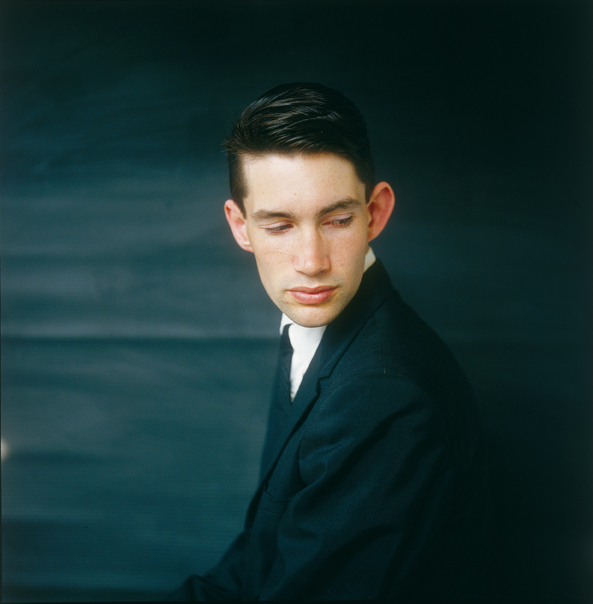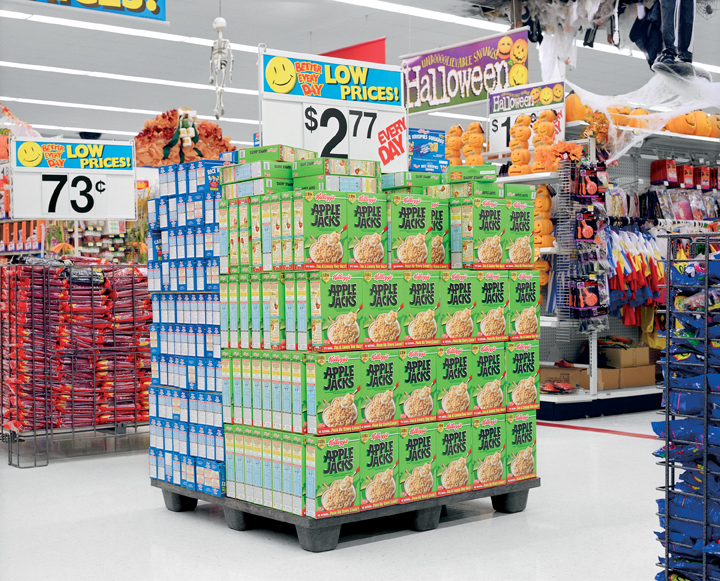[Spring 2008]
Vancouver Art Gallery, Vancouver
October 20, 2007 – January 20, 2008
A landmark showing of the work of Vancouver School photographer Roy Arden should not go unnoticed! In his long career investigating the interrupted zones of society, Arden has chronicled not only a landscape in transition but a social and visual field. Against the Day is a title that refers to the photographer’s term for shooting against the light (source); also, for Arden, “day” means the realm of economy and “night” the realm of anarchy. It is interesting to witness Arden make the jump from expressionist-influenced photographer with zeitgeist to more invisible chronicler of a world in which beauty (like the devil) is in the details. The exhibition includes Self Portrait (#1), a Cibachrome print of Arden with his jacket over his head in traditional stance with his twin-lens Roleiflex, as well as countless colour portraits and visual details of urban existence in the Fragments series. Among the portrait subjects are Ian Wallace, Stan Douglas, and Greg Girard(all 1981–85); the subject of the somewhat romantic Brassaï-like Discarded Chairs (#1), Geneva (1981–85) is a random and very sculptural and Tinguely-like assemblage of ordinary chairs in a chaotic entanglement. Life Magazines (#1), Vancouver (1981–85) tells the tale of Vancouver’s very concrete and material taste for the image as object, something that Arden has taken further and further as his career progresses, moving from images of people and objects, to images about imagery, to images about various idiomatic attitudes, to contemporary artmaking and photography.
Re-enactments and re-phrasings of history, very relevant to British Columbia’s (and Canada’s) colonial history, are brought together in a non-chronological way. Aboriginals re-enact the Passion Play in Mission, B.C., in 1898, and The Komagata Maru (1985) captures images of Indian immigrants on a ship that was turned back from British Columbia. The sequential images have document numbers (… 119, 120, 121, 122, 123…), reinforcing the anonymity of these individuals’ identities. It all looks like something out of the First World War with the infantry, crew, and distant immigrants aboard ship . Surprisingly, this works well with Arden’s photos of Arthur Erickson’s Museum of Anthropology on the grounds of the University of British Columbia. The totems are oddly dislocated and ethereal amid flat glass and columned interiors. What a strange comment on how everything has evolved from a potlatch culture to reserves and lost cultures in an urban wilderness. The stray, random images of detritus in the back alleys of Vancouver are poetic, sad, unforgiving. There is something marginal about avoiding the compositional phrase, the centring, or the hierarchy that beauty assumes. These images, whether the “Monster House,” Coquitlam, B.C. (1996) an out-of-scale mansion being set up in a high-speed economy for people with high-speed lives, or the old wood telephone pole, wire, and tree in Landfill, Richmond, B.C. (1991), are of a social landscape in transition. The accumulation of garbage over a sewer grate in Crow (2002), like the other photos, records a landscape of emptiness that is equally a place of desire, of something ultimately unattainable. The World as Will and Representation (2005), an ongoing DVD loop (available online at www.royarden.com), is a QuickTime movie with 28,000 images culled from the Internet. The images follow each other at such a speed that they seem nonsensical, as if images no longer represented any reality at all, but simply quantified a landscape of digital dimensionality. Arranged from A to Z, these images rationalize an otherwise irrational spread of absurd, speeded-up visuals. Archival pigment prints, such as Atomistic (2007) and Staring at the Sun (2007), take images from The World as Will and Representation and build them into visual digital collage structures. The density of visual information that we all access these days is communicated in a very up-to-now way.
Arden’s photo projects succinctly describe a trajectory from ideology to present-day global culture. Images of labour-union unrest in a series of panels use archival photos of the Vancouver Post Office riots in 1938. Threatened with being sent to labour camps in the interior of B.C., the men occupied the Vancouver Post Office and then the site of the Vancouver Art Gallery (a further irony). Blue panels above each image offer some sublime monochrome innocence or referencing of nature to counter the imagery of a more old-fashioned violence. Across the wall, a more recent image, Locked Out Men Striking, is totally devoid of ideology, as banal as watching TV. Supernatural (2005) captures hockey riots, a wanton expression of wilful violence in a culture driven to distraction that is amusing itself to death. Girls in a convertible holding a sign, “Without the Canucks there is No Hockey!,” cops holding down and handcuffing one person, an overturned car, broken glass on a sidewalk – all these images are mediatic and sensational, but there is something sadder about the hockey riots, that loss of ideology, than about the images from the 1930s.
On the second floor at the VAG, Arden has curated a show of contemporary works. As he states, “I often think the metaphor of ‘constellations’ best describes an artist’s imagination of cultural tradition.” That inner constellation, for Arden, includes Lorraine Gilbert’s Shaping the New Forest C-prints, a striking Francisco Goya etching, Rodney Graham’s Rome Ruins (1978) C-prints, Richard Hamilton’s Kent State (1970) screenprint, Lewis Hine’s Western Union Bicycle Messenger, Jerry Pethick’s fresnel lens–enabled Radio Crux (1994), a Bill Bissett box assemblage poetry piece, and Robert Smithson’s Drawings for Glue Pour (ca. 1970), a work that is ironically recalled in Pulp Mill Dump (#2), Nanaimo, B.C. (1992), with its swath of matter lying in a tumble on a hillside. And so Arden’s fascinating photographic play catches him on the crux of the document, something that he understands both historically and as a metaphor for international culture. He achieves this with a distance and perspective on modernity, on history, that is the hallmark of the Vancouver School of photographers.
John K Grande is the author of Balance: Art and Nature; Intertwining: Landscape, Technology, Issues, Artists; Art Nature Dialogues: Interviews with Environmental Artists; and Dialogues in Diversity: Art from Marginal to Mainstream.



